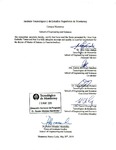| dc.contributor.advisor | Zúñiga, Alex Elías | |
| dc.creator | Borbolla Torres, César Iván | |
| dc.date.accessioned | 2019-08-30T14:51:21Z | |
| dc.date.available | 2019-08-30T14:51:21Z | |
| dc.date.created | 2019-05 | |
| dc.identifier.citation | Borbolla, C.(2019).Design, simulation and application of a PCL membrane with TiO2 and Ag nanoparticles for a novel geometry fog water harvesting device (Tesis de maestría). Instituto Tecnológico y de Estudios Superiores de Monterrey, Monterrey, Nuevo León, México. | es_MX |
| dc.identifier.uri | http://hdl.handle.net/11285/633077 | |
| dc.description.abstract | Nowadays, the world faces an increasing water crisis problem that will become even more severe in the years to come. Fog-water harvesting represents an economical and efficient alternative to address water scarcity around the world. In this study a report on the development of Polycaprolactone (PCL) composite membranes using TiO2 nanoparticles (NPs), Ag NPs and Ag-TiO2 NPs is presented, besides the effect of using two different solvents, acetic acid and a mixture of chloroform and N,N-dimethylformamide (DMF), to achieve a hydrophobic material capable of assisting fog-water harvesting applications. The proposal of a novel geometry is presented validated through mechanical and air-flow simulation. Beside the investigation and development of a new manufacture procedure for the application of the composite polymer material on a commercial Rashel mesh to enhance its properties. Surface morphology and roughness were explored by scanning electron and infinity focus microscopy, a more homogeneous morphology was observed for composites elaborated with chloroform-DMF. The degree of crystallinity and structural properties were investigated by differential scanning calorimetry and x-ray diffraction. The interaction between PCL and the dopants NPs was studied by Fourier transform infrared spectroscopy, detecting a shift to lower wavenumbers in the principal polymer modes corroborating a compatibility between the solvents, the NPs and the PCL polymer matrix. The permeability of the membranes was analyzed by water contact angle and the mechanical performance was investigated by using a uniaxial quasi-static test and equibiaxial cyclic test. The results obtained show an improvement in such properties for the composites elaborated with chloroform-DMF. Air-flow simulation shows a smoother flux and focused condensation on the pores´ edges. Finite element analysis showed an increase on the mechanical stability of the mesh when the geometry is changed. The geometry proposed enhances water collection against planar profiles. Values obtained in the fog-water collection efficiency tests demonstrate the feasibility and the potential of the composite material developed whit the highest value of 5 l/m2/hr. achieved. This research is relevant to set the experimental parameters and the application procedure to manufacture a high collection efficiency fog-water harvesting device based on a PCL. | es_MX |
| dc.format.medium | Texto | es_MX |
| dc.publisher | Instituto Tecnológico y de Estudios Superiores de Monterrey | esp |
| dc.relation.isFormatOf | versión publicada | es_MX |
| dc.rights | Open Access | es_MX |
| dc.rights.uri | http://creativecommons.org/licenses/by-nc-nd/4.0/ | * |
| dc.subject | INGENIERÍA Y TECNOLOGÍA::CIENCIAS TECNOLÓGICAS::INGENIERÍA Y TECNOLOGÍA DEL MEDIO AMBIENTE::REGENERACIÓN DEL AGUA | es_MX |
| dc.subject.lcsh | Ingeniería y Ciencias Aplicadas / Engineering & Applied Sciences | es_MX |
| dc.title | Design, simulation and application of a PCL membrane with TiO2 and Ag nanoparticles for a novel geometry fog water harvesting device | es_MX |
| dc.type | Tesis de Maestría / master Thesis | es_MX |
| dc.contributor.committeemember | Martínez Romero, Oscar | |
| dc.contributor.mentor | Del Ángel Sánchez, Karina | |
| dc.publisher.institution | Instituto Tecnológico y de Estudios Superiores de Monterrey | es_MX |
| dc.subject.keyword | Composite membranas | es_MX |
| dc.subject.keyword | TiO2 nanoparticles | es_MX |
| dc.subject.keyword | Ag nanoparticles | es_MX |
| dc.subject.keyword | Water harvesting | es_MX |
| dc.subject.keyword | Hydrophobicity | es_MX |
| dc.subject.keyword | Manufacture | es_MX |
| dc.contributor.institution | School of Engineering and Sciences | es_MX |
| dc.contributor.institution | School of Engineering and Sciences | es_MX |
| dc.contributor.institution | Campus Monterrey | es_MX |
| dc.description.degree | Maestro en Nanotecnología | es_MX |
| dc.audience.educationlevel | Investigadores/Researchers | es_MX |
| dc.relation.impreso | 2019-05 | |



